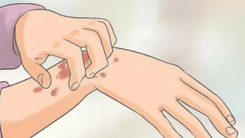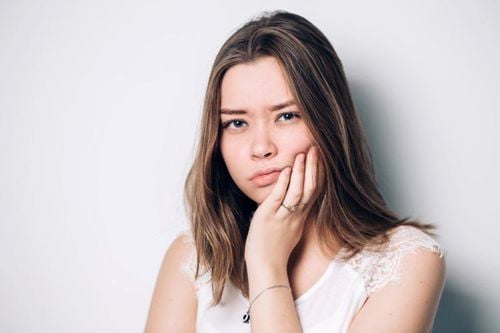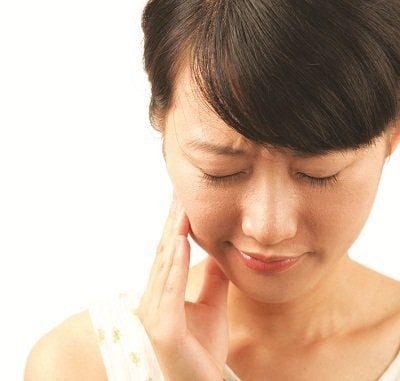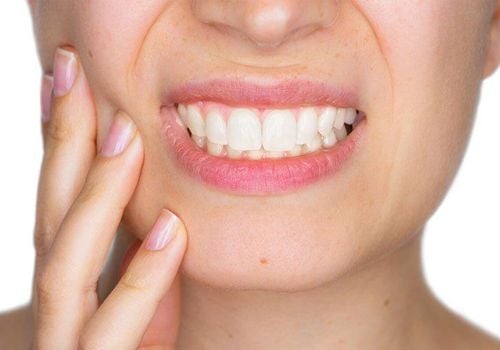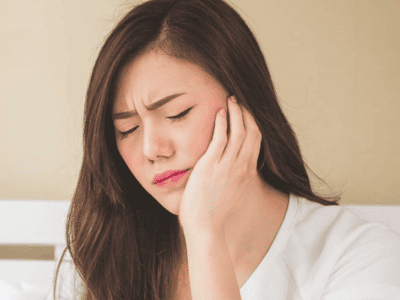Many people believe that orthodontics is a method to correct dental imperfections and improve bite, thereby helping to create a more balanced and harmonious facial appearance. However, in reality, does the change before and after orthodontics have any effect on the face?
1. How do teeth affect the face?
"Teeth and hair are the cornerstones of a person." Vietnamese people have long considered teeth and hair to be one of the criteria for assessing a person's beauty. The simple reason is that teeth and hair are the first impressions when interacting with others.
Accordingly, people with even, beautiful, white teeth contribute to creating a fresh, radiant face and create confidence in communication, smiling, or talking.
Conversely, people with uneven, crooked teeth directly affect the face, causing facial imbalance, especially the lower half of the face:
- Wide jaws and teeth in the anatomical structure of the bone or people with protruding teeth, large teeth... will make the mouth wide, large, rough and reduce the harmony of the face;
- Protruding teeth, underbite, misaligned teeth, malocclusion... are factors that cause facial imbalance, looking rough and angular.
For these reasons, cosmetic orthodontics is sought after by many people with the desire to create a positive, balanced, and more beautiful facial change before and after orthodontics.
2. Changes in facial parts before and after orthodontics?
Before and after orthodontics, positive changes to the face may include:
- For people with misaligned teeth that interfere with the bite, causing the face to look tense, skewed, or with postural disorders such as a slightly forward neck, tilted shoulders... When the change before and after orthodontics of both jaws brings the face to the correct ratio, relaxes the facial muscles because the obstacles are released, thereby the face will be more relaxed, gentle, and balanced;
- For people with signs of facial asymmetry due to the lower jaw being in the wrong position, the face before and after orthodontics will be balanced again;
- The nose angle is one of the changes before and after orthodontics: For example, people with a protruding jaw, after orthodontics, the upper lip will be retracted inward so the nose looks higher and more slender. However, people with a high nose are actually due to the development of cartilage, the thickness of the nasal wings, and are completely unrelated to the dental bone or jawbone. Therefore, orthodontics only helps to make the teeth more beautiful, the face becomes more harmonious and inadvertently creates the feeling that the nose is higher;
- Changes before and after orthodontics in the chin area: Cases that are elevated, pulled the lower jaw back or spread out the lower jaw teeth can make the chin slimmer, sometimes looking longer and creating a V-line shape;
- The most noticeable change before and after orthodontics is the even, healthy teeth that are easier to clean. At the same time, the gums are also firm, rosy, and less or no inflammation as before. This creates a healthy, attractive smile, improves confidence, and results in a fuller and more attractive face than before orthodontics;
- Changes in the face before and after orthodontics can be found in the lips. For example, in people with a protruding jaw, the upper front teeth protrude forward causing the lips to be turned up, the position of the lips in the canine area is also bulging, making the lips lack definition. When orthodontics pulls the upper and lower jaws back, the lips are no longer turned up. At the same time, the position of the lips in the 2nd and 3rd teeth area is slightly curved inward, helping the lips to be plump, slightly converging in the middle, and creating a contour.

3. Facial changes before and after orthodontics in specific cases
3.1. Changes before and after orthodontics for underbite
Before treatment, the patient's face will have a protruding lower jaw, a recessed upper jaw, and in some cases, a lisp. After orthodontics, the upper jaw will be moved forward, the lower jaw will be retracted, making the face change significantly, the nose will look higher, the lower jaw will be slimmer, and the nasolabial angle will become sharper.
3.2. How does the face change before and after orthodontics for overbite?
Overbite is a condition where the upper front teeth protrude excessively, causing the chin to appear recessed, difficulty closing the mouth, the chin is often wrinkled, creating a feeling of facial tension and discomfort, and at the same time, the cheeks are often sunken, making the cheekbones feel high.
After orthodontics, the patient's face will change a lot, in addition to even teeth, the patient will have a more beautiful face when the mouth can close naturally, the chin is longer, the nose looks higher, the cheeks will be plump and not tense, however, it is necessary to gain weight to cover the defect of high cheekbones if any because orthodontics does not inherently change the position of the cheekbones.
3.3. Facial changes before and after orthodontics for open bite treatment
Open bite will make the face look long, especially the lower face is not balanced with the upper facial levels, the upper lip is flared, the smile line is often horizontal, making the smile look quite naive.
The face before and after orthodontics will be adjusted to the most aesthetic standard in addition to closing the gap between the teeth naturally.
3.4. Facial changes before and after orthodontics for severe misaligned or crooked teeth
Misaligned teeth, severely crooked teeth when smiling will create a feeling that the patient's mouth has too many teeth. In that case, orthodontics will help to narrow the jaw by pulling the misaligned teeth into place, thereby making the patient's mouth no longer look wide, and pulling the jaw back also makes the nasolabial angle look more harmonious.
3.5. How does the profile change before and after orthodontics?
Cosmetic orthodontics with orthodontic appliances exerts a continuous light force on the teeth, helping to move the teeth to the desired position, thereby affecting the entire tooth root complex, alveolar bone, helping the face to change more positively, in some cases, even get the "divine profile" because the lips will no longer be protruding or recessed, the nose looks higher and slimmer.
Many patients after orthodontics have become more confident about their profile, the big change after orthodontics partly shows the positive results of the orthodontic method.
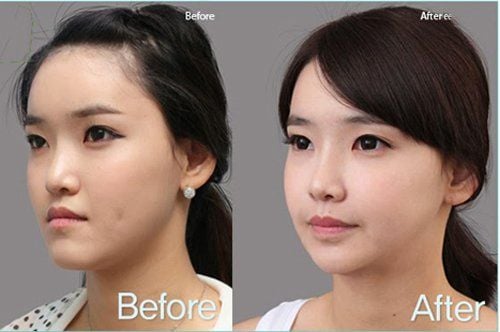
4. The degree of facial change before and after orthodontics in each subject
4.1. Orthodontics in children
Children and adolescents (under 16 years old) are very suitable for orthodontics because they can achieve the best results. At this age, orthodontics is easier to perform, and the movements of bending, adjusting teeth, gums, and jawbones are also more convenient... Accordingly, the change in the face before and after orthodontics usually goes in a positive direction, more beautiful and balanced.
Parents should pay attention to regular dental check-ups for their children to receive timely examination, advice, and treatment from doctors. This helps prevent the risk of misaligned teeth, overbite, underbite, loss of aesthetics..., helping children have a beautiful smile, a balanced face, and confidence in life.
4.2. Orthodontics in adults
Most adults tend to get braces with the main purpose of improving aesthetics or correcting existing defects on their teeth...
However, the teeth and jaw structure of adults have developed completely, quite hard and firm. This leads to a longer treatment time, a higher level of complexity, and the changes before and after orthodontics are usually not significant.
5. How does incorrect orthodontics negatively affect?
Negative changes before and after orthodontics may include:
- During the orthodontic process, we have to wear bulky braces frequently. Therefore, eating will be affected, which can lead to weight loss, sunken cheeks, sunken temples, and of course, these are not positive. However, these changes are only temporary, after completing orthodontics, eating habits will return to normal, these changes will disappear and concerns about appearance will go away;
- Orthodontics is considered a medical treatment, so besides the benefits, there are also complications if the wrong method is performed. Many cases of orthodontics, braces not only do not beautify but even damage the face before and after orthodontics;
- After orthodontics, the midline may be deviated and the smile will be crooked;
- Orthodontics causes the face to grow excessively in the vertical direction, causing imbalance;
- In cases where orthodontics cannot change the disproportion caused by too large a bone relationship such as the degree of overbite or underbite, the degree of open bite is too much... you can choose surgery to make the face look better after treatment;
The change in the face before and after orthodontics is quite significant, however, this also depends on the condition of the teeth and our requirements with the dentist. At the same time, to increase the aesthetic effect, besides orthodontics, we can combine it with a little cosmetic surgery to make the appearance even more beautiful.
In addition, choosing a reputable dental center with modern equipment and a team of experienced dentists helps increase the level of effectiveness and minimize the negative risks after orthodontics.
To arrange an appointment, please call … or make your reservation directly HERE. You may also download the MyVinmec app to schedule appointments faster and manage your reservations more conveniently.


